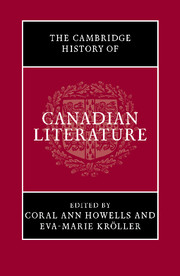Book contents
- Frontmatter
- Introduction
- PART ONE OLD AND NEW WORLD, LA NOUVELLE-FRANCE, THE CANADAS, DOMINION OF CANADA
- 1 Native societies and French colonization
- 2 Reports from la Nouvelle-France: the Jesuit Relations, Marie de l’Incarnation, and Élisabeth Bégon
- 3 Migrations, multiple allegiances, and satirical traditions: from Frances Brooke to Thomas Chandler Haliburton
- 4 Writing in the Northwest: narratives, journals, letters, 1700–1870
- 5 Literature of settlement
- 6 History in English and French, 1832–1898
- PART TWO THE POST-CONFEDERATION PERIOD
- PART THREE MODELS OF MODERNITY, POST-FIRST WORLD WAR
- PART FOUR AESTHETIC EXPERIMENTS, 1960 AND AFTER
- PART FIVE WRITING IN FRENCH
- Bibliography
- Index
- References
1 - Native societies and French colonization
from PART ONE - OLD AND NEW WORLD, LA NOUVELLE-FRANCE, THE CANADAS, DOMINION OF CANADA
Published online by Cambridge University Press: 28 September 2010
- Frontmatter
- Introduction
- PART ONE OLD AND NEW WORLD, LA NOUVELLE-FRANCE, THE CANADAS, DOMINION OF CANADA
- 1 Native societies and French colonization
- 2 Reports from la Nouvelle-France: the Jesuit Relations, Marie de l’Incarnation, and Élisabeth Bégon
- 3 Migrations, multiple allegiances, and satirical traditions: from Frances Brooke to Thomas Chandler Haliburton
- 4 Writing in the Northwest: narratives, journals, letters, 1700–1870
- 5 Literature of settlement
- 6 History in English and French, 1832–1898
- PART TWO THE POST-CONFEDERATION PERIOD
- PART THREE MODELS OF MODERNITY, POST-FIRST WORLD WAR
- PART FOUR AESTHETIC EXPERIMENTS, 1960 AND AFTER
- PART FIVE WRITING IN FRENCH
- Bibliography
- Index
- References
Summary
To explain why the Aztec empire crumbled before a small force of conquistadors, Tzvetan Todorov opined that the most important cause of its defeat was the absence of writing in Mexican culture. The Mexicans’ drawings and pictographs recorded experience, not language, and so they lacked the mental structures fostered by phonetic, grammatically organized writing. Aztec leaders lacked the ability to perceive and respond to new situations which writing presumably creates.
It is tempting to smile and dismiss such an evolutionist, Eurocentric, politically incorrect view of a non-European culture. But Todorov’s bias, whether writing is understood as a transcription of language or a pervasive system of difference, is close to the heart (so to speak) of other literary scholarship. The business of literary criticism has always been the analysis of written texts. Since the mid-twentieth century the structuralist and poststructuralist leveling of all representative forms to language, understood in terms of grammar and writing, has determined the focus and premises of other disciplines such as history and anthropology. The classic distinction between savagery and civilization is presented as a technical difference between orality and writing, and some leading anthropologists such as Clifford Geertz claim to “read” culture like a document. Nothing has really changed, however: the wolf is now the wolf in sheep’s clothing; concepts of primitivism and savagery are still at the core of anthropological and ethnohistorical practice. Todorov’s study of the Aztecs is an example of the risk that an oral / literate opposition entails: by its logic, he is led to assert that Aztec leaders were culturally, even mentally inferior to the Spanish invaders who destroyed their world. “Know what [the writer] thinks a savage is,” Geertz remarks, “and you have the key to his work.”
- Type
- Chapter
- Information
- The Cambridge History of Canadian Literature , pp. 7 - 28Publisher: Cambridge University PressPrint publication year: 2009



